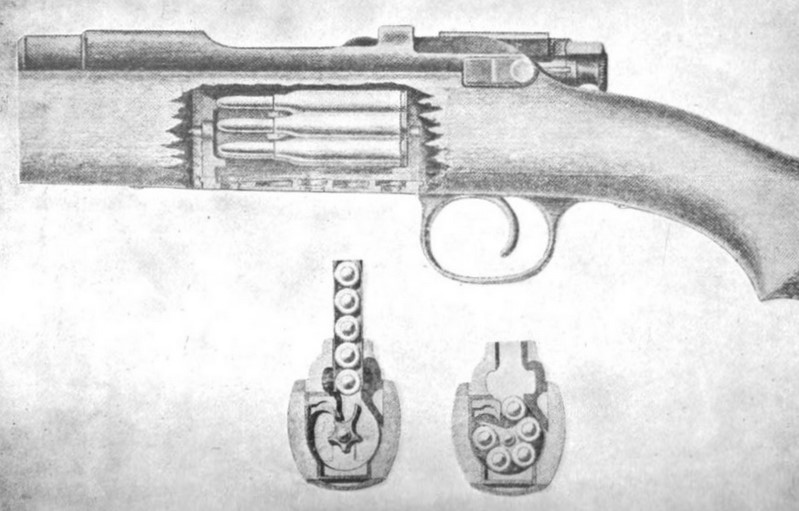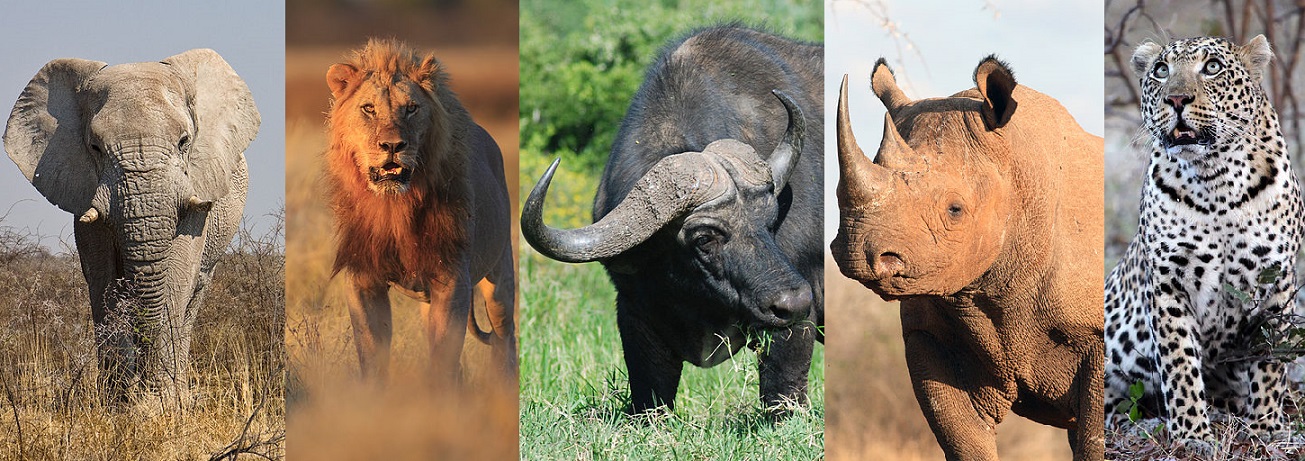|
9.5×57mm Mannlicher–Schönauer
The 9.5×57mm Mannlicher–Schönauer (MS) cartridge was adopted for the M-1910 MS rifle and carbine in 1910. (Note: The name Schoenauer is correctly spelled Schönauer with an “umlaut” over the “o” in German.) The 9.5×57mm MS is also known as the 9.5×56mm MS, the 9.5×56.7mm MS, and the .375 Rimless Nitro Express (RNE) × 2¼ (primarily in England). The cartridge may have been created by Westley-Richards and Eley in 1908 (rather than by the Oestereichischer Waffenfabrik-Gessellschaft, Steyr (OWS) (Austrian Arms Manufacturer-Association, Steyr)), but no production rifles in this caliber have been found prior to the M-1910. This development by or on behalf of Steyr was probably an answer to the development by the noted British gunmaking firm of Holland & Holland in 1905 of their .400/375 Belted Nitro Express, designed for their specially modified Mannlicher–Schoenauer rifle (they imported the actions from Austria, but built the rifles in house). Whether the develop ... [...More Info...] [...Related Items...] OR: [Wikipedia] [Google] [Baidu] |
Mannlicher–Schönauer
The Mannlicher–Schönauer (sometimes Anglicized as "Mannlicher Schoenauer", Hellenized as Τυφέκιον/Όπλον Μάνλιχερ, ''Óplon/Tyfékion Mannlicher'') is a rotary-magazine bolt-action rifle produced by Steyr Mannlicher for the Greek Army in 1903 and later used in small numbers by the Austro-Hungarian Army. Post-war it was sold for civilian use. Design characteristics In the late 19th century, the classic Mannlicher designs for the Austro-Hungarian army like the M1886 were based on the en-bloc magazine, a straight-pull bolt mechanism, designed for obsolete large caliber cartridges. Following the introduction of smokeless powder in the Lebel rifle at the end of the century, the Steyr factory worked on new Mannlicher designs, using more effective modern cartridges. These were offered for the consideration of the Austro-Hungarian Army, for export to other armies and for to civilian market. The rifle action was designed by Ferdinand Mannlicher and the rotary ... [...More Info...] [...Related Items...] OR: [Wikipedia] [Google] [Baidu] |
Recoil
Recoil (often called knockback, kickback or simply kick) is the rearward thrust generated when a gun is being discharged. In technical terms, the recoil is a result of conservation of momentum, as according to Newton's third law the force required to accelerate something will evoke an equal but opposite reactional force, which means the forward momentum gained by the projectile and exhaust gases (ejectae) will be mathematically balanced out by an equal and opposite momentum exerted back upon the gun. In hand-held small arms, the recoil momentum will be eventually transferred to the ground, but will do so through the body of the shooter hence resulting in a noticeable impulse commonly referred to as a "kick". In heavier mounted guns, such as heavy machine guns or artillery pieces, recoil momentum is transferred to the Earth's surface through the platform on which the weapon is mounted. In order to bring the rearward moving gun to a halt, the momentum acquired by the gun is di ... [...More Info...] [...Related Items...] OR: [Wikipedia] [Google] [Baidu] |
World War II
World War II or the Second World War, often abbreviated as WWII or WW2, was a world war that lasted from 1939 to 1945. It involved the vast majority of the world's countries—including all of the great powers—forming two opposing military alliances: the Allies and the Axis powers. World War II was a total war that directly involved more than 100 million personnel from more than 30 countries. The major participants in the war threw their entire economic, industrial, and scientific capabilities behind the war effort, blurring the distinction between civilian and military resources. Aircraft played a major role in the conflict, enabling the strategic bombing of population centres and deploying the only two nuclear weapons ever used in war. World War II was by far the deadliest conflict in human history; it resulted in 70 to 85 million fatalities, mostly among civilians. Tens of millions died due to genocides (including the Holocaust), starvation, ma ... [...More Info...] [...Related Items...] OR: [Wikipedia] [Google] [Baidu] |
German Silver
Nickel silver, Maillechort, German silver, Argentan, new silver, nickel brass, albata, alpacca, is a copper alloy with nickel and often zinc. The usual formulation is 60% copper, 20% nickel and 20% zinc. Nickel silver does not contain the element silver. It is named for its silvery appearance, which can make it attractive as a cheaper and more durable substitute. It is also well suited for being plated with silver. A naturally occurring ore composition in China was smelted into the alloy known as or () ("white copper" or cupronickel). The name "German Silver" refers to the artificial recreation of the natural ore composition by German metallurgists.Joseph Needham, Ling Wang, Gwei-Djen Lu, Tsuen-hsuin Tsien, Dieter Kuhn, Peter J Golas''Science and civilisation in China'' Cambridge University Press: 1974, , pp. 237–250 All modern, commercially important, nickel silvers (such as those standardized under ASTM B122) contain significant amounts of zinc and are sometimes considered ... [...More Info...] [...Related Items...] OR: [Wikipedia] [Google] [Baidu] |
Sights
A sight is an aiming device used to assist in visually aligning ranged weapons, surveying instruments or optical illumination equipments with the intended target. Sights can be a simple set or system of physical markers that have to be aligned together with the target (such as iron sights on firearms), or optical devices that allow the user to see an optically enhanced — often magnified — target image aligned in the same focus with an aiming point (e.g. telescopic sights, reflector sights and holographic sights). There are also sights that actively project an illuminated point of aim (a.k.a. "hot spot") onto the target itself so it can be observed by, such as laser sights and infrared illuminators on some night vision devices. Simple sights At its simplest, a sight typically has two components, front and rear aiming pieces that have to be lined up. Sights such as this can be found on many types of devices including weapons, surveying and measuring instruments, and nav ... [...More Info...] [...Related Items...] OR: [Wikipedia] [Google] [Baidu] |
Lion
The lion (''Panthera leo'') is a large Felidae, cat of the genus ''Panthera'' native to Africa and India. It has a muscular, broad-chested body; short, rounded head; round ears; and a hairy tuft at the end of its tail. It is sexually dimorphic; adult male lions are larger than females and have a prominent mane. It is a social species, forming groups called ''prides''. A lion's pride consists of a few adult males, related females, and cubs. Groups of female lions usually hunt together, preying mostly on large ungulates. The lion is an apex predator, apex and keystone predator; although some lions scavenge when opportunities occur and have been known to hunt Human, humans, lions typically don't actively seek out and prey on humans. The lion inhabits grasslands, savannas and shrublands. It is usually more diurnality, diurnal than other wild cats, but when persecuted, it adapts to being active nocturnality, at night and crepuscular, at twilight. During the Neolithic period, the li ... [...More Info...] [...Related Items...] OR: [Wikipedia] [Google] [Baidu] |
Rhinoceros
A rhinoceros (; ; ), commonly abbreviated to rhino, is a member of any of the five extant species (or numerous extinct species) of odd-toed ungulates in the family Rhinocerotidae. (It can also refer to a member of any of the extinct species of the superfamily Rhinocerotoidea.) Two of the extant species are native to Africa, and three to South and Southeast Asia. Rhinoceroses are some of the largest remaining megafauna: all weigh at least one tonne in adulthood. They have a herbivorous diet, small brains (400–600 g) for mammals of their size, one or two horns, and a thick (1.5–5 cm), protective skin formed from layers of collagen positioned in a lattice structure. They generally eat leafy material, although their ability to ferment food in their hindgut allows them to subsist on more fibrous plant matter when necessary. Unlike other perissodactyls, the two African species of rhinoceros lack teeth at the front of their mouths; they rely instead on their lips to pl ... [...More Info...] [...Related Items...] OR: [Wikipedia] [Google] [Baidu] |
Elephant
Elephants are the largest existing land animals. Three living species are currently recognised: the African bush elephant, the African forest elephant, and the Asian elephant. They are the only surviving members of the family Elephantidae and the order Proboscidea. The order was formerly much more diverse during the Pleistocene, but most species became extinct during the Late Pleistocene epoch. Distinctive features of elephants include a long proboscis called a trunk, tusks, large ear flaps, pillar-like legs, and tough but sensitive skin. The trunk is used for breathing, bringing food and water to the mouth, and grasping objects. Tusks, which are derived from the incisor teeth, serve both as weapons and as tools for moving objects and digging. The large ear flaps assist in maintaining a constant body temperature as well as in communication. African elephants have larger ears and concave backs, whereas Asian elephants have smaller ears, and convex or level backs. Elephants ... [...More Info...] [...Related Items...] OR: [Wikipedia] [Google] [Baidu] |
Big Five Game
In Africa, the Big Five game animals are the lion, leopard, black rhinoceros, African bush elephant, and African buffalo. They are examples of charismatic megafauna, featuring prominently in popular culture, and are among the most famous of Africa's large animals. The term was coined by big-game hunters, and refers to the five most difficult animals in Africa to hunt on foot but is now more widely used by game viewing tourists and safari tour operators. The 1990 and later releases of South African rand banknotes feature a different big-five animal on each denomination. Countries where all can be found include Angola, Botswana, Zambia, Uganda, Namibia, South Africa, Kenya, Tanzania, Zimbabwe, Mozambique, Eswatini, the Democratic Republic of the Congo, Rwanda and Malawi. Species Elephant The African bush elephant (''Loxodonta africana'') and African forest elephant (''Loxodonta cyclotis'') are the largest land-based animals. Elephants are herbivores with thick, almost hairles ... [...More Info...] [...Related Items...] OR: [Wikipedia] [Google] [Baidu] |
India
India, officially the Republic of India (Hindi: ), is a country in South Asia. It is the seventh-largest country by area, the second-most populous country, and the most populous democracy in the world. Bounded by the Indian Ocean on the south, the Arabian Sea on the southwest, and the Bay of Bengal on the southeast, it shares land borders with Pakistan to the west; China, Nepal, and Bhutan to the north; and Bangladesh and Myanmar to the east. In the Indian Ocean, India is in the vicinity of Sri Lanka and the Maldives; its Andaman and Nicobar Islands share a maritime border with Thailand, Myanmar, and Indonesia. Modern humans arrived on the Indian subcontinent from Africa no later than 55,000 years ago., "Y-Chromosome and Mt-DNA data support the colonization of South Asia by modern humans originating in Africa. ... Coalescence dates for most non-European populations average to between 73–55 ka.", "Modern human beings—''Homo sapiens''—originated in Africa. Then, int ... [...More Info...] [...Related Items...] OR: [Wikipedia] [Google] [Baidu] |
Africa
Africa is the world's second-largest and second-most populous continent, after Asia in both cases. At about 30.3 million km2 (11.7 million square miles) including adjacent islands, it covers 6% of Earth's total surface area and 20% of its land area.Sayre, April Pulley (1999), ''Africa'', Twenty-First Century Books. . With billion people as of , it accounts for about of the world's human population. Africa's population is the youngest amongst all the continents; the median age in 2012 was 19.7, when the worldwide median age was 30.4. Despite a wide range of natural resources, Africa is the least wealthy continent per capita and second-least wealthy by total wealth, behind Oceania. Scholars have attributed this to different factors including geography, climate, tribalism, colonialism, the Cold War, neocolonialism, lack of democracy, and corruption. Despite this low concentration of wealth, recent economic expansion and the large and young population make Afr ... [...More Info...] [...Related Items...] OR: [Wikipedia] [Google] [Baidu] |

.jpg)



_colourised.png)
